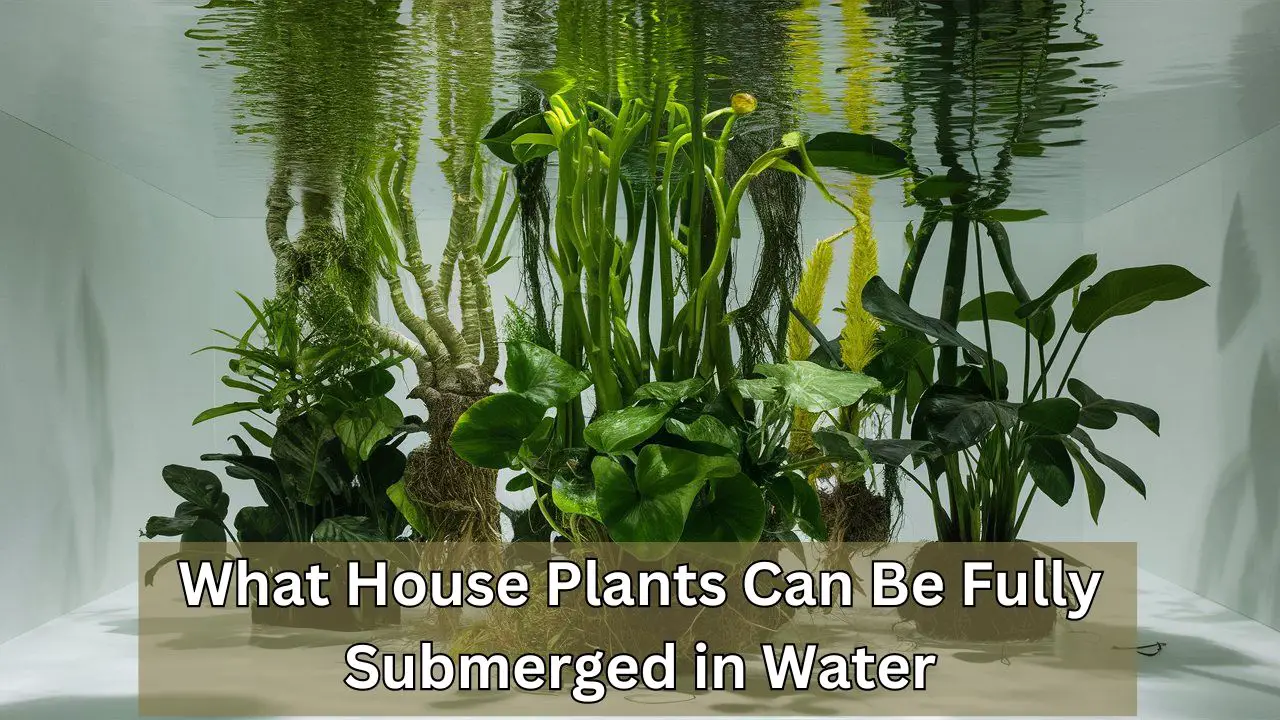Anubias, Java Fern, and Marimo Moss Ball can be fully submerged in water. They thrive in aquatic environments with proper care.
House plants that can be fully submerged in water are unique and fascinating. These plants are perfect for aquariums, water gardens, and hydroponic setups. They not only enhance the aesthetics of your space but also help in maintaining water quality.
Submerged plants like Anubias, Java Fern, and Marimo Moss Ball are easy to care for and require minimal maintenance. They can adapt to various water conditions and provide a natural habitat for aquatic life. Adding these plants to your home can create a serene and vibrant environment, making them a great choice for plant enthusiasts.
Introduction To Aquatic House Plants
Aquatic house plants are fascinating. They thrive when fully submerged in water. These plants bring a unique charm to your home. Their care routine is different from traditional house plants. By learning about them, you can enjoy a beautiful, underwater garden indoors.
Benefits Of Water Submersion
Submerging house plants in water has many advantages. Here are some key benefits:
- Low Maintenance: No need to water them regularly.
- Pest-Free: Water acts as a barrier against pests.
- Clean Environment: No soil means less mess.
- Visual Appeal: Clear containers show roots and plants beautifully.
General Care Tips
Caring for aquatic house plants is easy. Follow these tips for a thriving underwater garden:
- Choose the Right Container: Use clear glass for visual appeal.
- Change Water Regularly: Fresh water keeps plants healthy.
- Provide Adequate Light: Place near a window for bright, indirect light.
- Use Liquid Fertilizer: Add nutrients to the water monthly.
- Keep an Eye on Algae: Clean the container if algae appear.
Characteristics Of Submersible Plants
House plants that can be fully submerged in water have unique traits. These traits allow them to thrive in aquatic environments. Understanding these characteristics helps in choosing the right plants for your water garden.
Root Adaptations
Submersible plants have special root adaptations. Their roots can absorb oxygen directly from water. This is different from most land plants. These roots are often thin and spread out to increase oxygen uptake.
Some roots are also anchoring roots. These roots help plants stay in place in moving water. They are strong and can grip onto rocks or other surfaces.
Here is a table showing types of root adaptations:
| Root Type | Function |
|---|---|
| Thin Roots | Increase oxygen absorption |
| Anchoring Roots | Stabilize plant in water |
Leaf Structure
The leaf structure of submersible plants is also unique. Their leaves are often thin and flexible. This helps them move with water currents. Thin leaves also allow for better gas exchange.
Some plants have floating leaves. These leaves stay on the water surface to get more sunlight. Floating leaves are usually broad and flat.
Below is a list of common leaf adaptations:
- Thin leaves for gas exchange
- Flexible leaves for movement
- Floating leaves for sunlight
These adaptations make submersible plants well-suited for aquatic environments.
Top Submersible House Plants
Some house plants can thrive fully submerged in water. These plants are perfect for aquatic setups and bring a unique look to your home. Below are the top submersible house plants you can grow easily.
Anubias
Anubias is a popular choice for underwater gardening. This plant is durable and requires minimal care. Anubias can grow in low light and doesn’t need soil. Its leaves are thick and dark green, making it visually appealing.
Anubias grows slowly, so it won’t outgrow your tank quickly. Simply attach it to rocks or driftwood, and it will thrive. It’s a great option for beginners.
| Feature | Details |
|---|---|
| Light | Low to moderate |
| Growth Rate | Slow |
| Care Level | Easy |
Java Fern
Java Fern is another excellent submersible plant. This plant is also easy to care for and doesn’t need soil. Java Fern can grow in various lighting conditions, from low to high light.
Its leaves are long and narrow, adding a different texture to your tank. Java Fern can be attached to rocks or driftwood. It spreads slowly, making it manageable. This plant is perfect for both beginners and experienced gardeners.
| Feature | Details |
|---|---|
| Light | Low to high |
| Growth Rate | Slow to moderate |
| Care Level | Easy |
These submersible house plants are great for creating an underwater garden. They require low maintenance and are visually appealing. Start with Anubias and Java Fern for the best results.
Credit: www.quora.com
Creating An Aquatic Display
Transform your home into a serene oasis with an aquatic display. Fully submerged house plants create a mesmerizing underwater garden. This setup requires the right container and an eye for design.
Choosing The Right Container
Selecting the perfect container is crucial. A clear glass container works best. It lets you see the plants and water clearly.
- Size: Ensure the container is large enough for plant growth.
- Shape: A cylindrical or rectangular shape works well.
- Material: Glass or acrylic are ideal choices.
Avoid using metal containers. They can rust and harm your plants.
Designing For Visual Appeal
Design your aquatic display to be visually appealing. Arrange plants at different heights. Use stones or gravel for the base.
| Element | Purpose |
|---|---|
| Stones/Gravel | Provides a natural base and secures plant roots. |
| Plants | Adds greenery and purifies the water. |
| Decorations | Enhances aesthetic appeal and creates focal points. |
Follow these tips for a stunning display:
- Layer: Place taller plants at the back.
- Group: Combine plants with similar light needs.
- Balance: Distribute elements evenly.
Use colorful stones for a pop of color. Add small aquatic creatures like snails for movement.
Maintenance Of Submerged Plants
Keeping submerged plants healthy requires specific care. Proper maintenance ensures their growth and vibrancy. This section covers essential tips for maintaining submerged house plants.
Water Quality
High-quality water is vital for submerged plants. Ensure the water is clean and free from contaminants. Regularly check the water’s pH level. The ideal pH range is between 6.5 and 7.5.
Use a water conditioner if needed. This helps remove chlorine and other harmful chemicals. Changing the water every two weeks is recommended. This keeps the environment fresh and healthy for the plants.
Pruning And Cleaning
Regular pruning keeps the plants healthy. Remove dead or decaying leaves. This prevents rot and promotes new growth. Use clean, sharp scissors for pruning.
Cleaning the tank or container is equally important. Algae and debris can accumulate over time. Gently scrub the container’s sides with a soft brush. Avoid using harsh chemicals for cleaning. They can harm the plants.
| Task | Frequency |
|---|---|
| Water Change | Every 2 weeks |
| pH Check | Weekly |
| Pruning | Monthly |
| Container Cleaning | Monthly |
Maintaining submerged plants is simple with regular care. Follow these tips to keep your plants thriving.

Credit: www.reddit.com
Common Challenges And Solutions
Submerging house plants in water can be tricky. There are common challenges you might face. Here are solutions to make it easier.
Algae Control
Algae can grow quickly in water. They steal nutrients from your plants. To control algae, follow these tips:
- Change the water every week.
- Keep the container away from direct sunlight.
- Add a small amount of hydrogen peroxide to the water. It helps kill algae.
If algae persist, you can use an algae control product. Look for a product safe for plants.
Dealing With Rot
Rot is a common issue with submerged plants. It happens when roots or stems decay. To prevent rot, do these:
- Ensure the plant is healthy before submerging.
- Trim any dead or damaged parts.
- Use clean containers and fresh water.
If rot occurs, remove the affected parts immediately. Change the water and clean the container. This helps stop the spread of rot.
| Challenge | Solution |
|---|---|
| Algae Growth | Change water weekly, avoid sunlight, use hydrogen peroxide. |
| Plant Rot | Start with healthy plants, trim dead parts, use clean water. |
Benefits Of Submerged Plants In Home Aquariums
Submerging plants in home aquariums brings numerous benefits. These plants offer both practical and aesthetic advantages. They create a more balanced and visually appealing aquatic environment.
Ecosystem Balance
Submerged plants help maintain the aquarium ecosystem. They absorb excess nutrients from the water. This prevents algae growth and keeps the water clear.
Plants in water produce oxygen during photosynthesis. This oxygen benefits fish and other aquatic life. They also provide shelter and hiding spots for fish. This reduces stress and promotes better health.
| Benefit | Description |
|---|---|
| Absorbs Nutrients | Prevents algae growth and keeps water clear |
| Produces Oxygen | Supports fish and aquatic life |
| Provides Shelter | Reduces fish stress |
Aesthetic Value
Submerged plants enhance the visual appeal of aquariums. They add color and texture to the tank. This makes the aquarium more attractive and interesting.
Different plant types offer various shapes and sizes. This allows for creative and unique tank designs. Submerged plants create a natural and serene environment. This benefits both the tank inhabitants and observers.
- Adds color and texture
- Offers various shapes and sizes
- Creates a natural environment
Where To Find Submersible House Plants
Finding the right submersible house plants can be a fun adventure. Knowing where to look is the first step. There are two main places to find submersible house plants: local nurseries and online stores. Both have their pros and cons. This guide will help you decide the best place to buy healthy, submersible house plants.
Local Nurseries Vs. Online
Local nurseries offer a hands-on experience. You can see and touch the plants before buying. This helps in picking the healthiest plants. You can ask staff for advice and tips. Local nurseries support the community. The downside is they may have limited options.
Online stores offer a wide range of choices. You can browse many types of submersible plants. Online shopping is convenient. You can buy plants from the comfort of your home. The downside is you cannot see the plants in person before buying. Shipping can also harm delicate plants.
Selecting Healthy Plants
Choosing healthy submersible plants is important. Here are some tips:
- Check the leaves. They should be green and firm.
- Look at the roots. Healthy roots are white or light brown.
- Avoid plants with yellow or brown spots.
- Smell the soil. It should not smell bad.
- Ask about the plant’s water needs.
Buying plants from local nurseries or online stores has its own benefits. Make sure to pick the healthiest plants for the best results.
Frequently Asked Questions
What Houseplants Can Grow Fully Submerged In Water?
Anubias, Java Fern, and Amazon Sword can grow fully submerged in water. These aquatic plants thrive in submerged conditions.
What Houseplants Can Live In Water?
Spider plants, pothos, and lucky bamboo thrive in water. Philodendron, Chinese evergreen, and English ivy also grow well hydroponically.
What Plants Can Grow Solely In Water?
Spider plants, philodendrons, and pothos can grow solely in water. Lucky bamboo, peace lilies, and coleus also thrive.
Can Any Plant Grow Submerged?
Yes, many aquatic plants can grow submerged. Examples include water lilies, anacharis, and hornwort. These plants thrive underwater.
Conclusion
Choosing house plants that can be fully submerged in water offers unique and beautiful options. These plants can thrive with minimal care. Experiment with different varieties to find the best fit for your home. Enjoy the beauty and simplicity they bring.
Submerged house plants can transform your indoor space into a serene oasis.

My mission is to help you bring the beauty of nature indoors with expert advice, detailed plant care guides, and creative design ideas.




